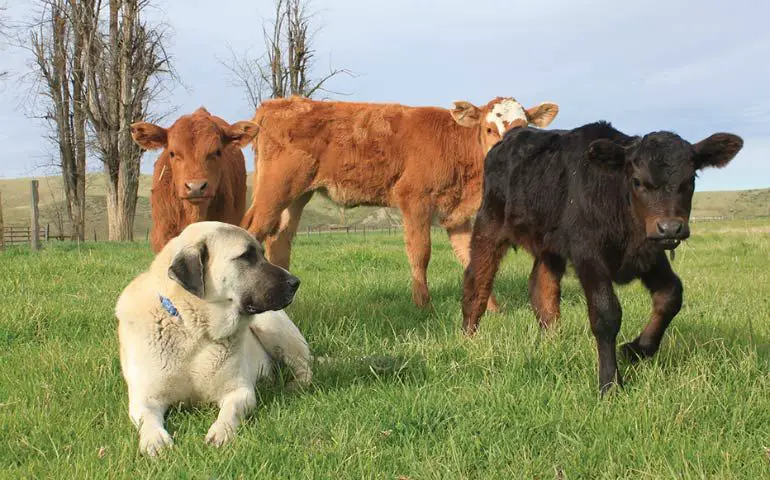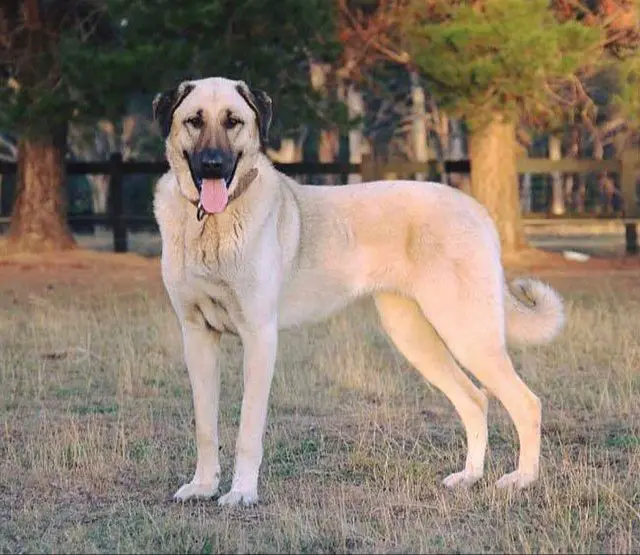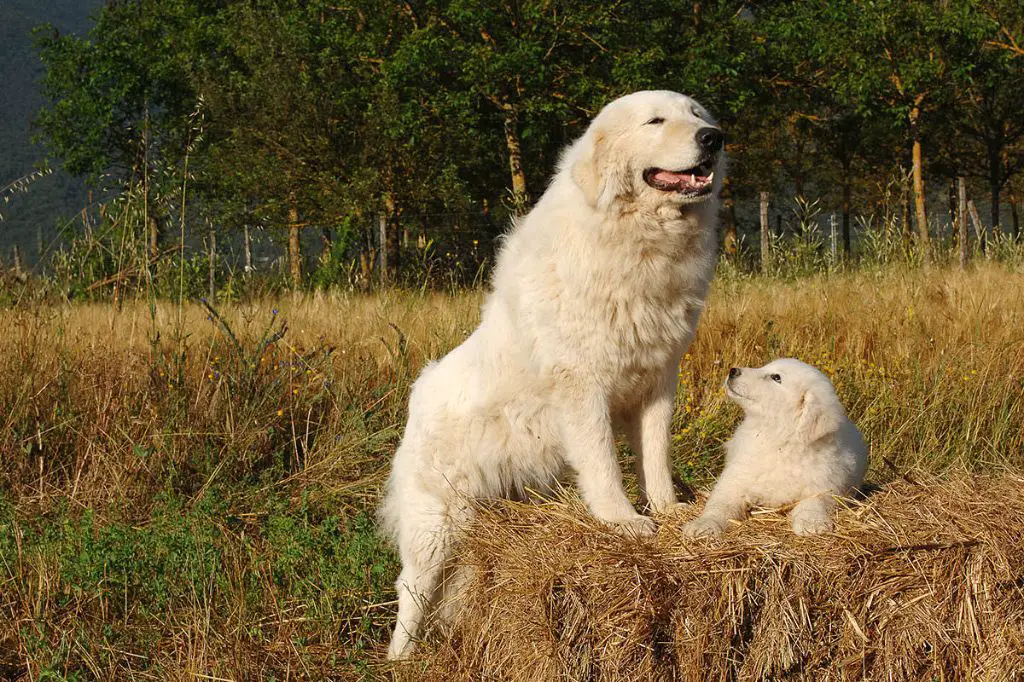Introducing the Brave Livestock Guardian Dogs
Livestock guardian dogs (LGDS) are a special breed of working dog that have been bred over centuries specifically for the purpose of protecting livestock from predators. According to Wikipedia, LGDS specialize in protecting small farm animals like sheep and goats against predators like coyotes, wolves, and bears. Unlike cattle or horses that can withstand attacks, smaller livestock are very vulnerable. LGDS utilize their large size, loud bark, and protective instincts to deter potential predators and keep flocks safe.
LGDS have strong guardian instincts and form tight bonds with the animals they protect. They live among the flock and patrol the perimeter, acting as a first line of defense against intruders. Their mere presence helps deter predators who recognize the LGDS as a formidable guardian not to be messed with. LGDS are most active at night when predators hunt, staying alert and ready to confront any threat. With an LGDS on duty, livestock owners can rest assured knowing their flock has a loyal protector watching over them.
The Anatolian Shepherd Dog
The Anatolian Shepherd Dog originated in the Anatolian Plateau of Turkey, where it was bred to guard livestock from threats like wolves, bears, and jackals. These large, rugged dogs have a history going back over 6,000 years. Their name comes from the region where they were developed, Anatolia. They likely share ancestry with other livestock guardian breeds like the Kangal, Akbash, and Tibetan Mastiff[1].

Anatolian Shepherd Dogs typically stand 27-29 inches tall and weigh between 90-150 pounds. They have a thick double coat that protects them from cold winters and hot summers. Their coat can come in a variety of colors like fawn, brindle, white, and piebald. They have a large head with drop ears and almond-shaped eyes. Their body is muscular and agile, built for life outdoors guarding flocks[2].
The Anatolian Shepherd Dog is independent, self-confident, and loyal. They bond closely with livestock and family. Their protective instincts make them good guardians that patrol the boundaries of their territory. With proper socialization, they can get along well with other pets and strangers. However, they often view unfamiliar animals as a threat. Training requires patience and consistency.
For centuries, Anatolian Shepherd Dogs have protected sheep and goats from predators in Turkey. Their large size, keen senses, and quick reflexes give them an advantage in repelling attacks. They continue to work as livestock guardians across the world today thanks to their devoted nature and working abilities.
The Kangal
The Kangal is originally from Turkey. It is considered to be one of the oldest livestock guardian breeds, with its origins tracing back hundreds of years in the Sivas region of Turkey according to https://haskangal.com/kangal-standard. The Kangal was developed to guard sheep and goats from predators like wolves, jackals and bears. It gets its name from the Kangal district in Turkey’s Sivas Province where it originated.
The Kangal is a large, powerful dog typically standing 28-34 inches tall and weighing 90-150 lbs. It has a dense double coat that comes in various shades of fawn, cream or pale gray with a black facial mask and ears. The Kangal is calm, devoted and protective. It bonds closely with livestock and displays a guarded, independent nature with strangers, though is not inherently aggressive. The Kangal possesses keen senses and great speed, strength and agility to confront threats. It actively patrols territory and deters predators with its imposing size and authoritative bark.

The Kangal excels at guarding sheep, goats, chickens and other livestock day and night in pastures, hills and mountainous areas. Its protective instincts are strong, yet the Kangal is sensible and won’t harm the flock. The Kangal stays alert, keeps predators away and alerts owners to any issues. This combination of attentiveness, strength and temperament make the Kangal well-suited to be a devoted livestock guardian.
The Akbash Dog
The Akbash dog originated in western Turkey, where it was bred to guard livestock from predators. References to large, white guardian dogs in Turkey date back at least 3,000 years (Hill’s Pet). The remote villages of western Turkey relied on these dogs to protect their flocks of sheep and goats from wolves, bears, and jackals. Over the centuries, the dogs developed into the breed known today as the Akbash.
Akbash dogs have a powerful, muscular build and a broad head. They typically stand 27-34 inches tall and weigh 90-130 pounds. Their white coat helps camouflage them among the sheep and reflects heat from the sun. Akbash dogs have a loyal, independent temperament. They bond closely with livestock and are very protective. Their strong guarding instincts allow them to deter predators without being aggressive towards herd members (Wisdom Panel).
As working livestock guardian dogs, Akbash are alert, patient, and distrustful of strangers. They patrol the perimeters of pastures and flocks, watching for intruders. Their large size and loud bark serve as a strong warning to predators. If confronted, an Akbash will attempt to chase rather than attack. They are powerful enough to confront coyotes, wolves, bears, and even lions. With proper socialization, Akbash dogs can also excel as family companions.

Training and Bonding With the Herd
Proper training and bonding of livestock guardian dogs (LGDs) with livestock is crucial for the dogs to be effective protectors. LGDs must form tight bonds with the animals they are meant to protect in order to view them as part of their pack. There are some key methods for facilitating this bonding process.
Socialization should begin when the LGD is still a puppy, ideally 8-16 weeks old. The puppy should be raised with the herd and have constant supervised access so it can properly imprint on the livestock. Feeding, playing with, and sleeping near the livestock will help the puppy bond with them. The puppy should also be handled frequently by the owner so it bonds with humans as well.
As the LGD matures, training should focus on reinforcing appropriate guardian behaviors. Verbally praising the dog for staying near the herd, investigating disturbances, and alarm barking at threats will encourage these actions. The dog should be corrected and redirected if it wanders, is too rough with livestock, or does not alert to predators. Setting clear boundaries and being consistent is important.
Proper bonding typically takes 1-2 years, after which the mature LGD will stay with the herd at all times, vigorously protecting them from any potential danger. Patience and commitment to the bonding and training process are necessary to produce an effective livestock guardian dog.[1]
Deterring Predators

Livestock guardian dogs are highly effective at deterring predators like lions from attacking livestock. They use a variety of techniques to keep predators away:
- Intimidating barking – LGDs have loud, deep barks that can deter predators from up to a mile away
- Scaring off – The large size and confident presence of LGDs is often enough to scare predators like lions and keep them away from the livestock
- Confrontation – If intimidation doesn’t work, LGDs will directly confront predators and chase them off the property
- Patrolling territory – LGDs regularly patrol the perimeter of their territory, marking it and reinforcing their presence, which keeps predators from wanting to enter
Studies show that properties with LGDs see significantly lower rates of livestock loss to predators. In some cases, the presence of the dogs was enough to deter lion attacks completely [1]. LGDs bond closely with the livestock they protect and are very dedicated to keeping them safe 24/7.
Protecting Livestock 24/7
Livestock guardian dogs work tirelessly to protect livestock day and night. Unlike herding dogs that actively control livestock movement, LGDs use their protective instincts to defend livestock from predators and other threats. They live full-time with the herd or flock they protect and accompany them wherever they graze or range during the day. At night when the livestock are bedded down, the LGDs continue patrolling the area and sounding alarms at signs of danger (Source).
Thanks to their guardian breed instincts, LGDs naturally watch over “their” animals very closely. They position themselves to have a full view of the livestock and their surroundings. The dogs observe predators from a distance and place themselves between the predator and livestock to discourage an attack. Many LGDs use an intimidating presence and loud bark to scare away coyotes, wolves, bears, and other predators (Source).
While LGDs are attentive and protective by nature, proper socialization, training, and time to bond with the livestock are still very important for the dogs to be effective guardians. With maturity, livestock-guardian dogs gain experience determining which animals threaten the livestock and when to intervene. They learn to gently encourage wayward livestock back to the rest of the group and deter unfamiliar animals. This round-the-clock protection makes LGDs a valuable asset for ranchers and shepherds.
Real-World Success Stories
Livestock guardian dogs have proven successful at deterring lion attacks on farms and ranches worldwide. In Namibia, Anatolian shepherds reduced livestock losses from lions by 80-100% after being introduced on cattle farms (https://mountainlion.org/coexistence/at-the-homestead/). One California ranch saw a 93% drop in lion predation after acquiring a pair of Akbash dogs (https://westernlivingjournal.com/livestock-guardian-dogs-western-predators-foe/).
LGDs use their imposing size, loud barking, and protective nature to keep lions away from the herd. They will confront lions and chase them off, whereas the prey animals alone would be helpless. The dogs bond closely to the livestock they guard and are very effective at reducing kills. With LGDs on patrol, livestock and lions can co-exist with minimal conflicts.
Challenges and Considerations
While livestock guardian dogs can provide excellent protection for herds and flocks, there are some potential challenges and considerations to keep in mind before getting one of these working dogs (source). LGD breeds like the Anatolian Shepherd, Kangal, and Akbash are not typical household pets. They are independent, strong-willed, and have powerful guarding instincts deeply embedded in their DNA.
LGDs generally do not thrive in suburban or urban settings. Their guarding behaviors like patrolling, barking, and marking territory can lead to neighbor complaints and misunderstandings. They require special socialization, training, containment, and supervision to properly manage their protective instincts around strangers, children, other pets, and vehicles.
While LGDs can bond closely with their owners, their priority is always the herd or flock they are guarding. They are not eager-to-please and highly trainable like some working breeds. LGDs will follow their own initiative based on guarding instincts rather than human direction. Owners need patience, experience handling guardian breeds, and appropriate expectations.
Before acquiring an LGD, carefully consider your lifestyle, property setup, ability to meet the dog’s unique needs, and whether a guardian breed is truly the best fit. Thorough research and preparation is required to ensure a good outcome both for the dog and livestock the LGD is meant to protect (source).
The Valuable Role of the Livestock Guardian Dog
Livestock guardian dogs play an extremely important role in protecting livestock from predators. They have been used for thousands of years to guard sheep, goats, cattle, and other livestock from threats like wolves, coyotes, bears, and even lions. These loyal working dogs bond closely with the animals they protect and stay alert to defend “their” herd or flock day and night [1].
Unlike herding dogs that actively round up livestock, livestock guardian dogs keep a watchful eye and use their imposing presence to deter predators. If confronted, they may confront predators aggressively to drive them away or hold them at bay until the threat retreats. With proper training and socialization, livestock guardian dogs can provide an invaluable service protecting livestock and reducing losses for farmers and ranchers [2].
While not a complete solution for all predation issues, livestock guardian dogs have proven themselves time and again as an effective part of an integrated predator control program. Their continual presence and strong protective instincts make them a valuable asset for livestock producers seeking to reduce losses from predators in a humane, sustainable way.
